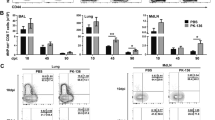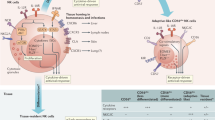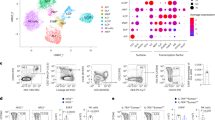Abstract
The elimination of viruses and tumors by natural killer cells is mediated by specific natural killer cell receptors. To study the in vivo function of a principal activating natural killer cell receptor, NCR1 (NKp46 in humans), we replaced the gene encoding this receptor (Ncr1) with a green fluorescent protein reporter cassette. There was enhanced spread of certain tumors in 129/Sv but not C57BL/6 Ncr1gfp/gfp mice, and influenza virus infection was lethal in both 129/Sv and C57BL/6 Ncr1gfp/gfp mice. We noted accumulation of natural killer cells at the site of influenza infection by tracking the green fluorescent protein. Our results demonstrate a critical function for Ncr1 in the in vivo eradication of influenza virus.
This is a preview of subscription content, access via your institution
Access options
Subscribe to this journal
Receive 12 print issues and online access
$259.00 per year
only $21.58 per issue
Buy this article
- Purchase on SpringerLink
- Instant access to full article PDF
Prices may be subject to local taxes which are calculated during checkout






Similar content being viewed by others
References
Yokoyama, W.M., Kim, S. & French, A.R. The dynamic life of natural killer cells. Annu. Rev. Immunol. 22, 405–429 (2004).
Vankayalapati, R. et al. The NKp46 receptor contributes to NK cell lysis of mononuclear phagocytes infected with an intracellular bacterium. J. Immunol. 168, 3451–3457 (2002).
Warfield, K.L. et al. Role of natural killer cells in innate protection against lethal ebola virus infection. J. Exp. Med. 200, 169–179 (2004).
Moretta, A. et al. Activating receptors and coreceptors involved in human natural killer cell-mediated cytolysis. Annu. Rev. Immunol. 19, 197–223 (2001).
Moretta, L. & Moretta, A. Unravelling natural killer cell function: triggering and inhibitory human NK receptors. EMBO J. 23, 255–259 (2004).
Pessino, A. et al. Molecular cloning of NKp46: a novel member of the immunoglobulin superfamily involved in triggering of natural cytotoxicity. J. Exp. Med. 188, 953–960 (1998).
De Maria, A. et al. Identification, molecular cloning and functional characterization of NKp46 and NKp30 natural cytotoxicity receptors in Macaca fascicularis NK cells. Eur. J. Immunol. 31, 3546–3556 (2001).
Biassoni, R. et al. The murine homologue of the human NKp46, a triggering receptor involved in the induction of natural cytotoxicity. Eur. J. Immunol. 29, 1014–1020 (1999).
Falco, M., Cantoni, C., Bottino, C., Moretta, A. & Biassoni, R. Identification of the rat homologue of the human NKp46 triggering receptor. Immunol. Lett. 68, 411–414 (1999).
Storset, A.K., Slettedal, I.O., Williams, J.L., Law, A. & Dissen, E. Natural killer cell receptors in cattle: a bovine killer cell immunoglobulin-like receptor multigene family contains members with divergent signaling motifs. Eur. J. Immunol. 33, 980–990 (2003).
Mandelboim, O. & Porgador, A. NKp46. Int. J. Biochem. Cell Biol. 33, 1147–1150 (2001).
Karre, K. NK cells, MHC class I molecules and the missing self. Scand. J. Immunol. 55, 221–228 (2002).
Sivori, S. et al. NKp46 is the major triggering receptor involved in the natural cytotoxicity of fresh or cultured human NK cells. Correlation between surface density of NKp46 and natural cytotoxicity against autologous, allogeneic or xenogeneic target cells. Eur. J. Immunol. 29, 1656–1666 (1999).
Sivori, S. et al. Triggering receptors involved in natural killer cell-mediated cytotoxicity against choriocarcinoma cell lines. Hum. Immunol. 61, 1055–1058 (2000).
Sivori, S. et al. Involvement of natural cytotoxicity receptors in human natural killer cell-mediated lysis of neuroblastoma and glioblastoma cell lines. J. Neuroimmunol. 107, 220–225 (2000).
Weiss, L., Reich, S., Mandelboim, O. & Slavin, S. Murine B-cell leukemia lymphoma (BCL1) cells as a target for NK cell-mediated immunotherapy. Bone Marrow Transplant. 33, 1137–1141 (2004).
Spaggiari, G.M. et al. NK cell-mediated lysis of autologous antigen-presenting cells is triggered by the engagement of the phosphatidylinositol 3-kinase upon ligation of the natural cytotoxicity receptors NKp30 and NKp46. Eur. J. Immunol. 31, 1656–1665 (2001).
Mandelboim, O. et al. Recognition of haemagglutinins on virus-infected cells by NKp46 activates lysis by human NK cells. Nature 409, 1055–1060 (2001).
Arnon, T.I. et al. Recognition of viral hemagglutinins by NKp44 but not by NKp30. Eur. J. Immunol. 31, 2680–2689 (2001).
Costello, R.T. et al. Defective expression and function of natural killer cell-triggering receptors in patients with acute myeloid leukemia. Blood 99, 3661–3667 (2002).
De Maria, A. et al. The impaired NK cell cytolytic function in viremic HIV-1 infection is associated with a reduced surface expression of natural cytotoxicity receptors (NKp46, NKp30 and NKp44). Eur. J. Immunol. 33, 2410–2418 (2003).
Markel, G. et al. The mechanisms controlling NK cell autoreactivity in TAP2-deficient patients. Blood 103, 1770–1778 (2004).
Schleypen, J.S. et al. Renal cell carcinoma-infiltrating natural killer cells express differential repertoires of activating and inhibitory receptors and are inhibited by specific HLA class I allotypes. Int. J. Cancer 106, 905–912 (2003).
Bloushtain, N. et al. Membrane-associated heparan sulfate proteoglycans are involved in the recognition of cellular targets by NKp30 and NKp46. J. Immunol. 173, 2392–2401 (2004).
Biron, C.A., Byron, K.S. & Sullivan, J.L. Severe herpesvirus infections in an adolescent without natural killer cells. N. Engl. J. Med. 320, 1731–1735 (1989).
Stein-Streilein, J. & Guffee, J. In vivo treatment of mice and hamsters with antibodies to asialo GM1 increases morbidity and mortality to pulmonary influenza infection. J. Immunol. 136, 1435–1441 (1986).
Biron, C.A., Nguyen, K.B., Pien, G.C., Cousens, L.P. & Salazar-Mather, T.P. Natural killer cells in antiviral defense: function and regulation by innate cytokines. Annu. Rev. Immunol. 17, 189–220 (1999).
Orange, J.S. Human natural killer cell deficiencies and susceptibility to infection. Microbes Infect. 4, 1545–1558 (2002).
Arnon, T.I. et al. The mechanisms controlling the recognition of tumor- and virus-infected cells by NKp46. Blood 103, 664–672 (2004).
McVicar, D.W. et al. Aberrant DAP12 signaling in the 129 strain of mice: implications for the analysis of gene-targeted mice. J. Immunol. 169, 1721–1728 (2002).
Arase, H., Saito, T., Phillips, J.H. & Lanier, L.L. Cutting edge: the mouse NK cell-associated antigen recognized by DX5 monoclonal antibody is CD49b (α2 integrin, very late antigen-2). J. Immunol. 167, 1141–1144 (2001).
Rolink, A. et al. A subpopulation of B220+ cells in murine bone marrow does not express CD19 and contains natural killer cell progenitors. J. Exp. Med. 183, 187–194 (1996).
Oberg, L. et al. Loss or mismatch of MHC class I is sufficient to trigger NK cell-mediated rejection of resting lymphocytes in vivo - role of KARAP/DAP12-dependent and -independent pathways. Eur. J. Immunol. 34, 1646–1653 (2004).
Vitale, M. et al. NKp44, a novel triggering surface molecule specifically expressed by activated natural killer cells, is involved in non-major histocompatibility complex-restricted tumor cell lysis. J. Exp. Med. 187, 2065–2072 (1998).
Biassoni, R. et al. Human natural killer cell receptors: insights into their molecular function and structure. J. Cell. Mol. Med. 7, 376–387 (2003).
Long, E.O. Tumor cell recognition by natural killer cells. Semin. Cancer Biol. 12, 57–61 (2002).
Diefenbach, A., Jamieson, A.M., Liu, S.D., Shastri, N. & Raulet, D.H. Ligands for the murine NKG2D receptor: expression by tumor cells and activation of NK cells and macrophages. Nat. Immunol. 1, 119–126 (2000).
Starr, T.K., Jameson, S.C. & Hogquist, K.A. Positive and negative selection of T cells. Annu. Rev. Immunol. 21, 139–176 (2003).
Sivori, S. et al. IL-21 induces both rapid maturation of human CD34+ cell precursors towards NK cells and acquisition of surface killer Ig-like receptors. Eur. J. Immunol. 33, 3439–3447 (2003).
Colucci, F. et al. Natural cytotoxicity uncoupled from the Syk and ZAP-70 intracellular kinases. Nat. Immunol. 3, 288–294 (2002).
Nagy, A., Rossant, J., Nagy, R., Abramow-Newerly, W. & Roder, J.C. Derivation of completely cell culture-derived mice from early-passage embryonic stem cells. Proc. Natl. Acad. Sci. USA 90, 8424–8428 (1993).
Qimron, U. et al. Non-replicating mucosal and systemic vaccines: quantitative and qualitative differences in the Ag-specific CD8+ T cell population in different tissues. Vaccine 22, 1390–1394 (2004).
Acknowledgements
Supported by the Israel Science Foundation (O.M.), the Binational Science Foundation (O.M.), the Israel Ministry of Health and the European Commission (LSHC-CT-2002-518178 to O.M.).
Author information
Authors and Affiliations
Corresponding author
Ethics declarations
Competing interests
The authors declare no competing financial interests.
Supplementary information
Supplementary Figure 1
Generation of Ncr1gfp/gfp mice. (PDF 541 kb)
Supplementary Figure 2
Ncr1gfp expression in NK cells after PGK-neor excision in 129/sv mice. (PDF 402 kb)
Supplementary Figure 3
NK cell-specific Ncr1gfp expression in 129/sv mice after PGK-neor excision. (PDF 401 kb)
Supplementary Figure 4
C57BL/6 mice express Ncr1gfp in NK cells. (PDF 426 kb)
Supplementary Figure 5
NK cell-specific Ncr1gfp expression in C57BL/6 mice. (PDF 421 kb)
Rights and permissions
About this article
Cite this article
Gazit, R., Gruda, R., Elboim, M. et al. Lethal influenza infection in the absence of the natural killer cell receptor gene Ncr1. Nat Immunol 7, 517–523 (2006). https://doi.org/10.1038/ni1322
Received:
Accepted:
Published:
Issue date:
DOI: https://doi.org/10.1038/ni1322
This article is cited by
-
Natural killer cells in antiviral immunity
Nature Reviews Immunology (2022)
-
Leukocyte trafficking to the lungs and beyond: lessons from influenza for COVID-19
Nature Reviews Immunology (2021)
-
Maternal natural killer cells at the intersection between reproduction and mucosal immunity
Mucosal Immunology (2021)
-
Multicolor two-photon imaging of in vivo cellular pathophysiology upon influenza virus infection using the two-photon IMPRESS
Nature Protocols (2020)
-
An intravital window to image the colon in real time
Nature Communications (2019)



